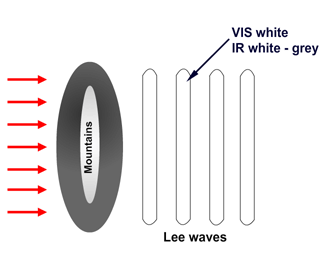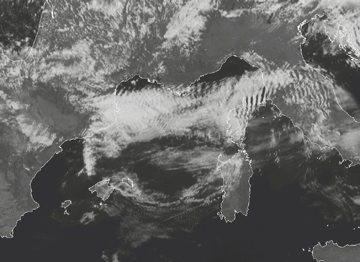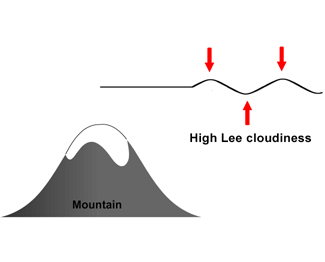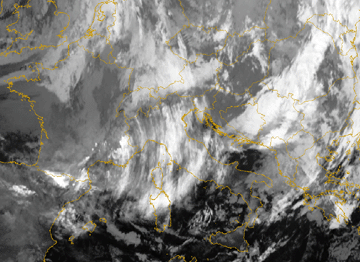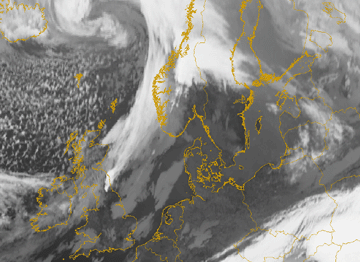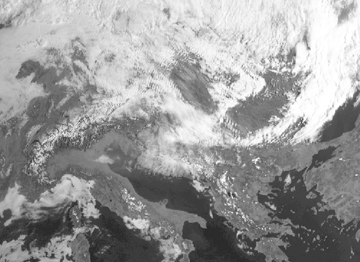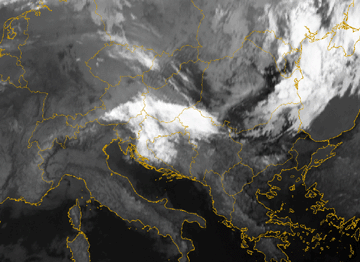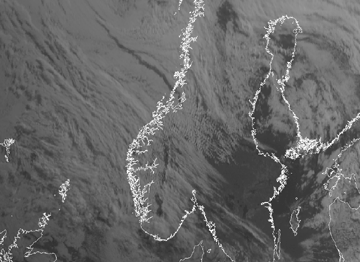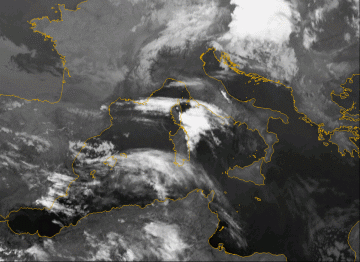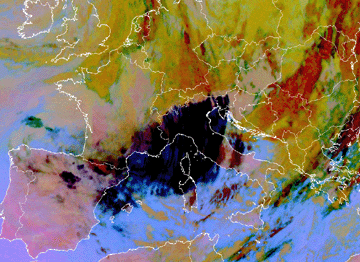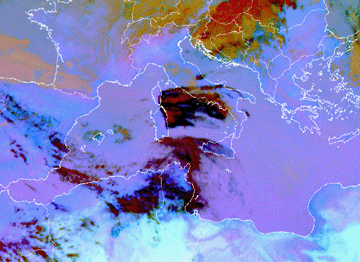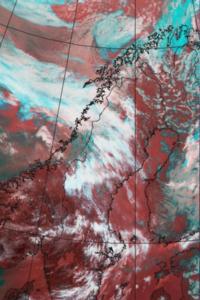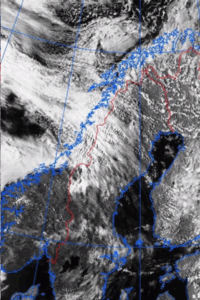Cloud Structure In Satellite Images
Lee Cloudiness is one result of orographically influenced air flow on the lee side of a mountain. Depending on the atmospheric conditions two types of cloudiness can be observed:
- Lee Wave Clouds, which are characterised by narrow middle level cloud bands perpendicular to the wind direction and parallel to the mountain chain. The length of the wave varies in range from about 3 - 40 km. They can easily be observed with high resolution images (e.g. Meteosat Second Generation and METOP polar orbiting satellite). Their crests are always white in the visible image but in the IR image they can vary from white to dark grey depending on their temperature (cloud top height).
|
|
|
|
04 July 2007/09.30 UTC - Meteosat 9 HRVIS image
|
|
The image shows well developed Lee Waves over Corsica, formed by the mountains in the northern part. To the west even Lee Waves that developed over the Pyrenees are observed.
- High Lee Cloudiness consisting of cirrus clouds that extend from the mountain chain over the leeward side, and continue for up to 1000 km. They are also formed by Lee Waves but have a much larger wave length. They are very bright in the IR image with cloud top temperatures ranging from -35 to -55°C but rather grey or translucent in the VIS image. Sometimes in strong winds they become detached from the mountain and then seem to start far away from the obstacle.
|
|
|
|
12 November 2006/23.30 UTC - Meteosat 8 IR10.8 image
|
|
High and thin Lee clouds have formed over the Southern part of the Alps. The cloudiness is extending very far to the south, across Italy.
|
11 April 2005/23.30 UTC - Meteosat 8 IR10.8 image
|
|
The image reveals two areas with high Lee cloudiness. First, Lee clouds that formed over England and are in the image found over the North Sea. Second area of interest is over the Norwegian mountains where high Lee Cloudiness is being formed and is extending far into Sweden and the Baltic Sea. The sharp boundary of the mountain ridge on which the Lee clouds develop is well observed for both areas.
Sometimes Lee Wave Clouds and High Lee Cloudiness can be observed together. In this case the IR image is the best tool for the identification of High Lee Cloudiness, just south of the Austrian Alps; the HRVIS image for the lower Lee Wave Clouds over Slovakia and Hungary is also evident. The high resolution shows the existence of Lee waves very well
|
18 March 2005/07.45 UTC - Meteosat 8 HRVIS image
|
18 March 2005/06.00 UTC - Meteosat 8 IR10.8 image
|
Sometimes the Lee Waves are situated immediately behind the mountain and the High Lee Cloudiness is found further downwind.
|
28 June 2005/04.45 UTC - Meteosat 8 HRVIS image
|
28 June 2005/04.45 UTC - Meteosat 8 IR10.8 image
|
The two images above show Lee Cloudiness over the Norwegian Mountains. Lee Waves are situated immediately behind this mountain chain whereas high Lee cloudiness is found extending far to the east over Southern Norway and Southern Sweden.
Both types of Lee Cloudiness are frequently found over many mountain chains in Europe. In Europe they can be found at the Pyrenees, the Alps, the Carpathians Mountains, the Scandinavian Mountains, the Central Mountains in France, Iceland, the Apennines, the Cantabrian Mountains, the High Tatra, the mountains of Scotland, the mountains of England (Wales), Corsica and the East coast of Spain. Lee Cloudiness can also be found sometimes in Portugal, Greece, the Azores, the Baleares and the Faeroes Islands.
Lee Cloudiness normally has a duration of only several hours. Only in very few cases will it survive more than one day. The spatial scale ranges from small cloud patches (limitation is the resolution of the observation) up to several hundred kilometres.
Lee Wave Clouds are detected quite easily in VIS images. Identification of High Lee Cloudiness is more difficult; for instance High Lee Cloudiness and MCSs can have the same shape and brightness. Since Lee Cloud is associated with its mountain there is normally no propagation upwind. So discrimination between Lee Cloudiness and other possibly superimposed conceptual models such as moving systems is possible. Satellite loops can also be used to determine if Lee Cloudiness is detached from the mountain chain by strong winds.
|
08 May 2005/09.00 UTC - Meteosat 8 IR10.8 image
|
08 May 2005/04.30 UTC - Meteosat 8 IR10.8 image; 04.30 - 12.00 UTC half-hourly image Loop
|
Lee Cloudiness can also easily be detected with the help of RGB satellite images computed from the different Meteosat Second Generation IR images. Especially with the Dust RGB the high Lee clouds are easily discriminated.
|
12 November 2006/23.00 UTC - Meteosat 8 Dust RGB image
|
08 May 2005/09.00 UTC - Meteosat 8 Dust RGB image
|
Although it would seem inappropriate to use the Dust RGB for detecting Lee clouds the above two examples shows the contrary. The Dust RGB was originally designed for the detection and monitoring of dust. The RGB is comprised of the brightness temperature difference (BTD) of channels IR12.0 and IR10.8 on red, the BTD of IR10.8 and IR8.7 on green and finally on blue channel IR10.8 is projected. The BTD of IR12.0 and IR10.8 is a measure of the optical thickness which makes this RGB so useful. The high, cold and thin lee clouds appear as black in this RGB.
Appearance in AVHRR images
- Narrow cloud lines parallel to the mountain ridge line consist mostly of low or middle level clouds with a width of about 3 - 40 kilometres for both the cloud and the cloud-free lines. In NOAA 124 images they have white or yellow colour and in NOAA 345 images mostly cyan or light red colour.
- The NOAA 345 image is the most suitable tool to study High Lee Cloudiness. In the 345 image Lee Clouds are seen as white and are well identifiable against the dark red colour of the surface.
- A stationary Ci plume of High Lee Cloudiness can extend hundreds of kilometres downwind from the mountain ridge and has a sharp edge over the mountain chain. In AVHRR images the plume may have either a uniform or striped appearance. Ci plumes develop at high levels, therefore they are seen as white or blue in NOAA 124 images and mainly white in NOAA 345 images.
- Lee Clouds are sometimes associated with strong down slope winds causing a narrow dry zone along the lee slope. This can result in a gap in the Lee Cloudiness just behind the mountain ridge, clearly identifiable in AVHRR images.
|
28 July 1999/15.34 UTC - NOAA RGB image (channel 1, 2 and 4)
|
28 July 1999/15.34 UTC - NOAA RGB image (channel 3, 4 and 5)
|
|
28 July 1999/15.34 UTC - NOAA Ch2 image
|
28 July 1999/15.34 UTC - NOAA Ch4 image
|
This example illustrates both of the above-mentioned Lee Cloud types. A strong west-northwesterly jet stream is blowing across the Norwegian mountains causing narrow cloud lines parallel to the mountain ridge; these lines are best seen in the NOAA 124 image. The Cirrus plume extends a few hundred kilometers downstream to central Sweden.

